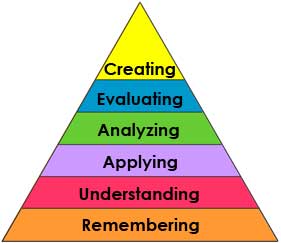2b. Bloom’s taxonomy
Course subject(s)
2. Constructing well-formulated learning objectives
Bloom’s taxonomy: From lower order thinking skills to higher order thinking skills
A helpful tool when writing learning objectives is Bloom’s taxonomy. This is a hierarchical classification of levels in learning. Bloom and his colleagues devised it in 1956 and it has proved hugely influential in course design. In 2001 the taxonomy was revised by former students of Bloom to reflect more recent shifts in emphasis (Anderson and Krathwohl). The 2001 version is represented here.

Remembering: can the student remember information?
Examples of verbs: define, list, name
Examples of learning objectives:
After having followed this course, the student is able to sum up possible properties for approximations (e.g. explicitness/implicitness, robustness, monotonicity, wiggles, spin-up time, stiffness).
Students can define the following analysis methods: interpolation and classification.
Understanding: can the student explain concepts?
Example of verbs: explain, paraphrase, illustrate
Examples of learning objectives:
The student is able to identify different properties for a given approximation (e.g. explicitness/implicitness, robustness, monotonicity, wiggles, spin-up time, stiffness).
Students are able to describe the movement of bony segments of the human skeleton system.
Applying: can the student use information in a new way?
Examples of verbs: apply, calculate, implement
Examples of learning objectives:
The student is able to calculate the shear and bending moment resistance of pre-stressed concrete structures, both statically determinate and statically indeterminate.
Students should be able to structure a given computational problem into logical and organized coding elements (i.e., functions and subroutines).
Analysing: can the student identify parts and their relationship?
Examples of verbs: analyse, compare, contrast
Examples of learning objectives:
Students are able to analyse, visualize and query given datasets.
Students should be able to derive equations describing the steady-state performance of the machines discussed during the course.
Evaluating: can the student justify a position?
Examples of verbs: judge, argue, debate
Examples of learning objectives:
Students are able to synthesize results of their queries into a meaningful conclusion and to evaluate the quality of data.
The student is able to support and defend his/her results.
Creating: can the students produce new products, theories or points of view?
Examples of verbs: create, design, develop
Examples of learning objectives:
Students can design systems engineering solutions through the use of requirements analysis and conceptual designs.
Students are able to develop feasible solutions that will lead to a better integration of renewable energy technologies and energy-efficient technologies in products and systems
Both the original and revised version of Bloom’s taxonomy should be treated with a little caution as we know that learning is messy rather than linear. You might feel that the hierarchy is somewhat different in your discipline, and the action verbs used may have different meanings in different contexts. If you regard the taxonomy as a tool and not as a straitjacket, it will prove very helpful.
In the following document you’ll find suggestions for verbs to use in your learning objectives for every level of Bloom’s taxonomy.
The following is a similar document, but with Dutch verbs.

Development of Teaching and Active Learning by TU Delft OpenCourseWare is licensed under a Creative Commons Attribution-NonCommercial-ShareAlike 4.0 International License.
Based on a work at https://ocw.tudelft.nl/courses/development-teaching-active-learning/.



